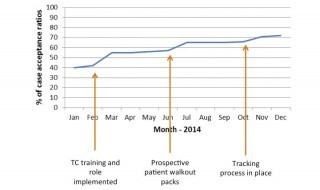 Calling all practices – Lina Craven of Dynamic Perceptions says KPIs can be a key driver to improve your business
Calling all practices – Lina Craven of Dynamic Perceptions says KPIs can be a key driver to improve your business
The old management adage of, ‘You can’t manage what you don’t measure’ is still applicable today. Whilst there are many different techniques for measuring the performance of your organisation, the use of key performance indicators (or KPIs) is the most reliable and commonly used technique. KPIs have become a popular topic for business leaders over recent years and are now a fundamental aspect of any business management.
Although the concept is relatively new to orthodontic practices, the introduction of the ‘Transitional commissioning of primary care orthodontic services’ has placed the need for measuring performance at the forefront of practice management. The challenges practices face today with measuring practice performance includes:
• Understanding what to measure
• Selecting the right KPIs
• How a practice should respond.
Whether you have a private practice targeting a specific demographic sector in the local area or an NHS contract looking to secure a multi-year contract, KPIs are an effective tool to help monitor and manage practice performance according to your set goals.
Understand what to measure
One of the cardinal sins of performance management is to select the KPIs without understanding the goals of your practice. To do so could set you off in a direction that is unrealistic and not only becomes a waste of resource and time, but may impact other qualities that your practice is known for.
Tip #1: Invest the time and effort to define the goals the practice wants to achieve. Once established you can now start developing KPIs that effectively measure your performance against these goals.
Selecting the right KPIs
The next step is ensuring that your KPIs are SMART – specific, measurable, attainable, relevant, timely (Peter Drucker – www.druckerinstitute.com). All too often there is a tendency to source an excessive number of KPIs from an MBA handbook, or the latest business blog. It is vital that when introducing the use of KPIs to manage the performance of your practice that you focus on what is critical to achieving your goals. There is no perfect number but using five KPIs is a good starting point.
A simple example of a practice’s goal could be to increase case acceptance ratios by 25% in 2014. So let’s assume that practice ABC in 2014 had a conversion rate from consultation to treatment start of 40% (Figure 1). This is the current KPI for this specific goal.

Tip #2: Select KPIs that are SMART. Start off with a small number of KPIs. Present the KPIs in a simple to understand format. Review on a regular basis to understand how the practice is performing and respond accordingly.
How a practice should respond to a KPI measurement
Often the hardest action in establishing an overall KPI capability is to understand when and how to respond to a KPI measurement. This is where you need to implement any changes in order to meet the goal, ie increase case acceptance by 25% in 12 months.
I recommend a quarterly review of KPIs as realistic to allow time for data collection, data analysis and planning as to how the practice should respond to a KPI measurement to achieve the set goal. Still using the example above, a practice may decide that to increase case acceptance ratios a treatment coordinator role is required, walkout packs are needed to remind prospective patients of the benefits from orthodontic treatment or that introducing a robust tracking process is essential. Whatever intervention is required, it needs to be aimed at achieving the goal (see graph).

Using this technique would allow you to quarterly measure your practice’s performance against the goal, and depending on the KPI result, allow you to make better informed decisions to help achieve the end goal (Figure 2).
Tip #3: Responding to KPIs on a regular basis will allow you to make informed decisions about your performance against set goals.
Performance management and the NHS vital signs
This NHS guidelines ‘Transitional commissioning of primary care orthodontic services’ introduces the concept of indicators for assessing performance management (these indicators are associated with the NHS ‘Vital signs’ schedule of each contract). Whilst these requirements are ‘transitional’, Dynamic Perceptions has been studying the NHS expectations in terms of data collection and analysis and how practices can accurately present these indicators to the area teams to ensure the best possible outcome.
In a nutshell, these guidelines focus on five KPIs to evaluate the overall level of quality and value for money your practice offers. Each of these KPIs will be given an individual score, which will be calculated to determine your overall rating and in turn will determine whether your contract is to be renewed, and if so by how long and if changes are to be applied to the renewed contract.
Ask yourself these questions:
• Does my practice understand the KPIs that the NHS requires to demonstrate a high level of service and offer value for money?
• Does my practice understand the potential consequences with failing to meet a certain quality rating using KPIs?
• Does my practice understand how to formulate and implement a strategy that can inform NHS area teams how you intend to meet the ‘excellence’ rating?
Lina Craven is the founder of Dynamic Perceptions a specialist orthodontic consultancy. Lina has over 20 years’ experience working in the orthodontic sector helping practices bring their vision for a successful and exceptional business to life. Other core services offered by Dynamic Perceptions include staff training, practice marketing, contract procurement and social media support.
www.dp-practiceconsultancy.com


